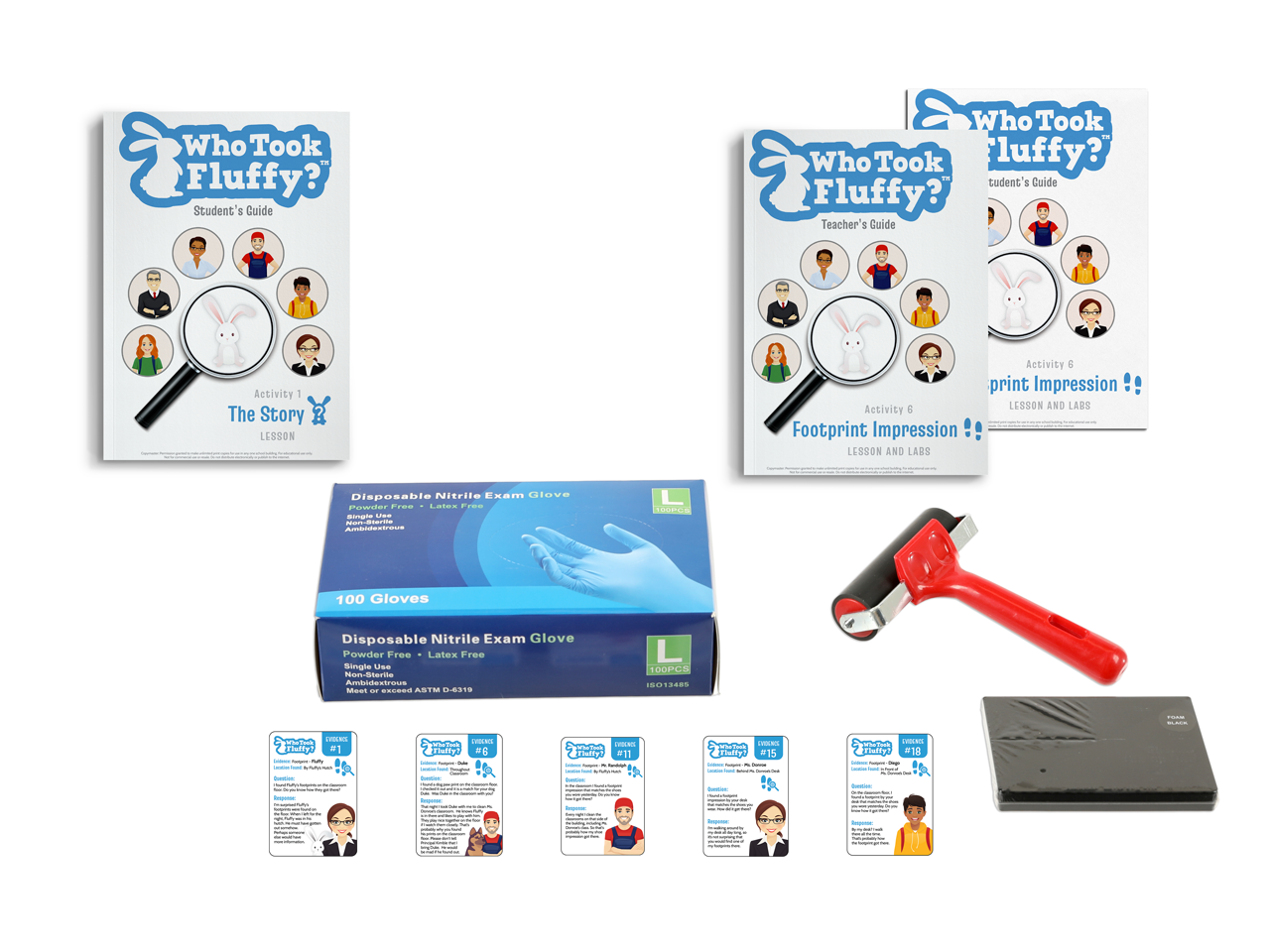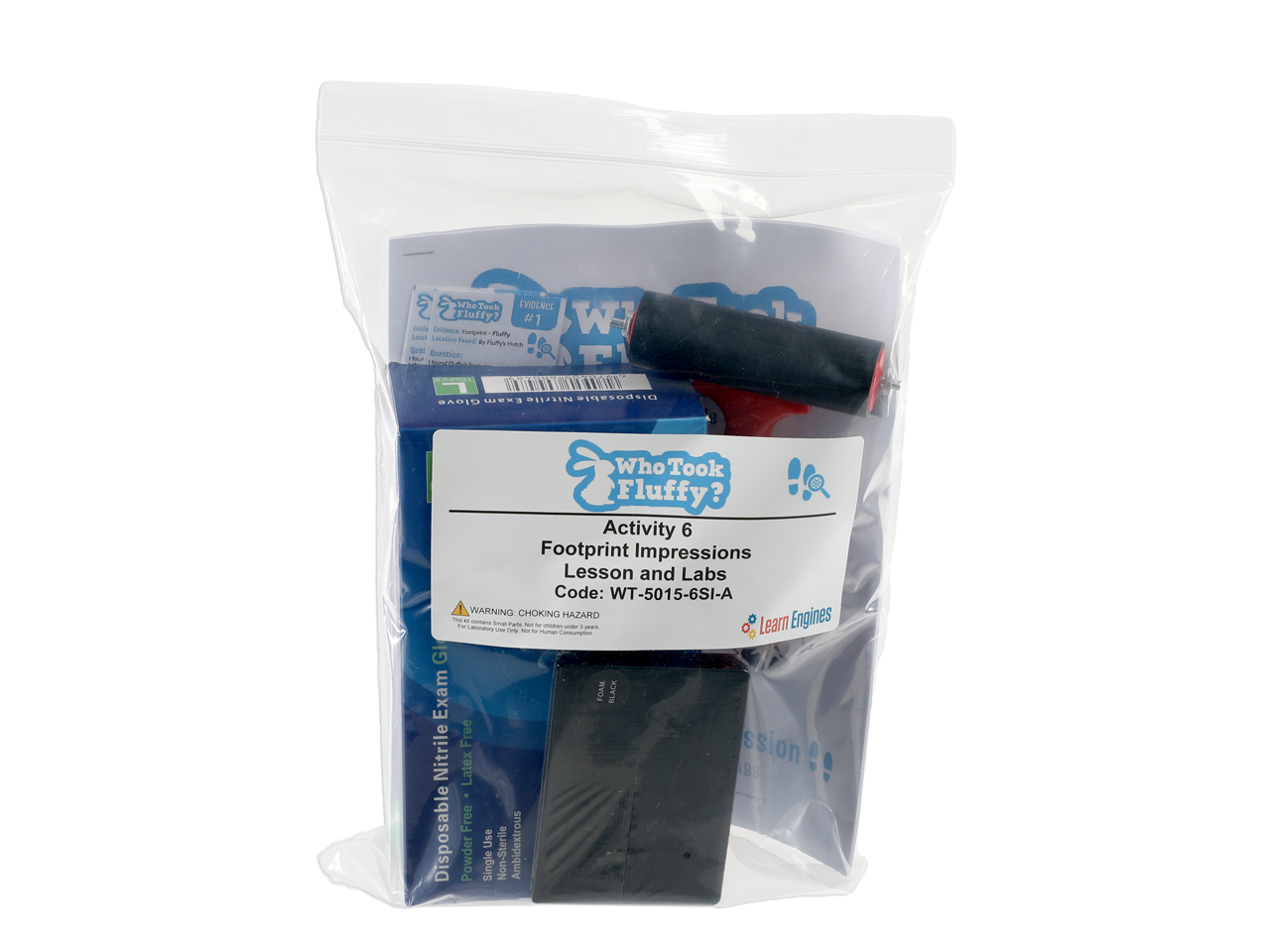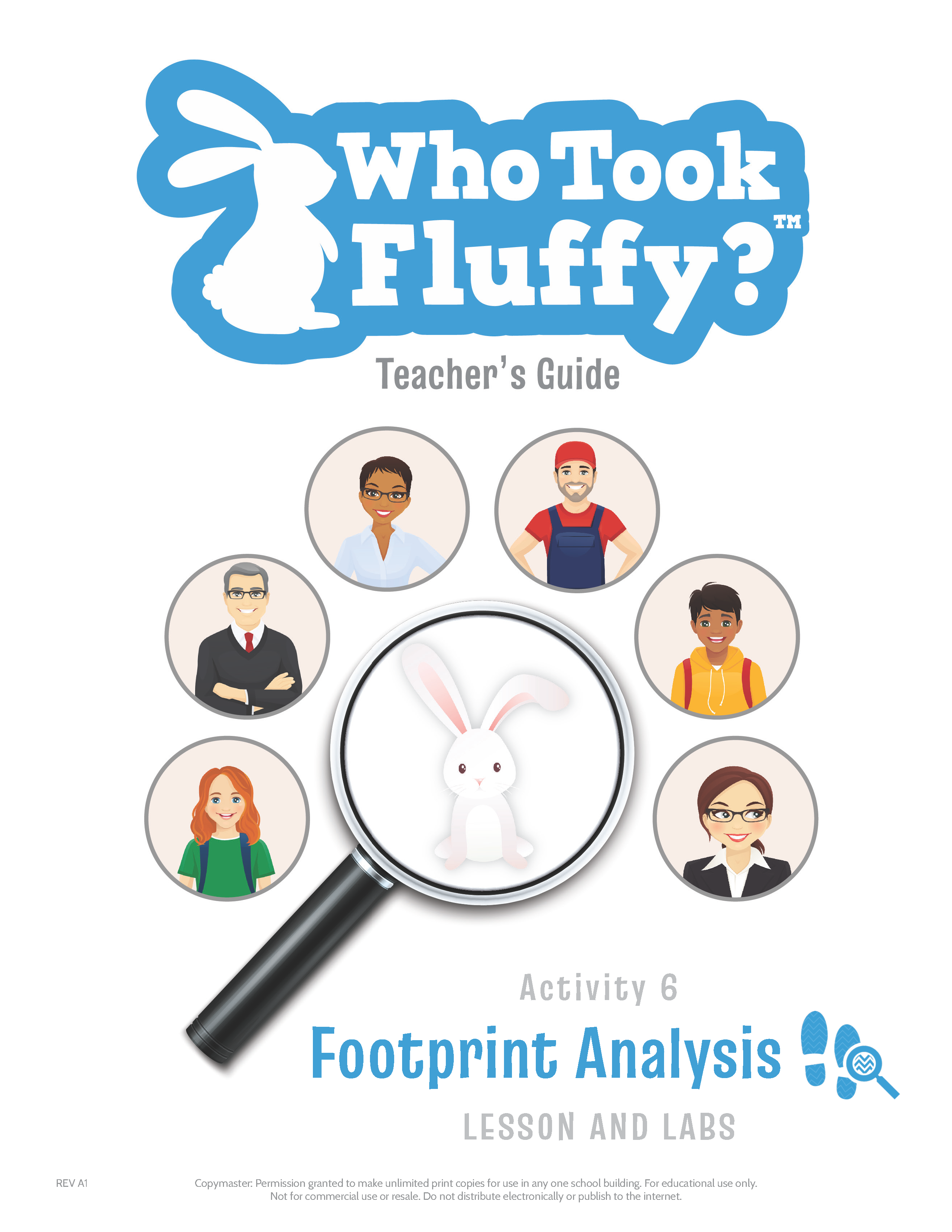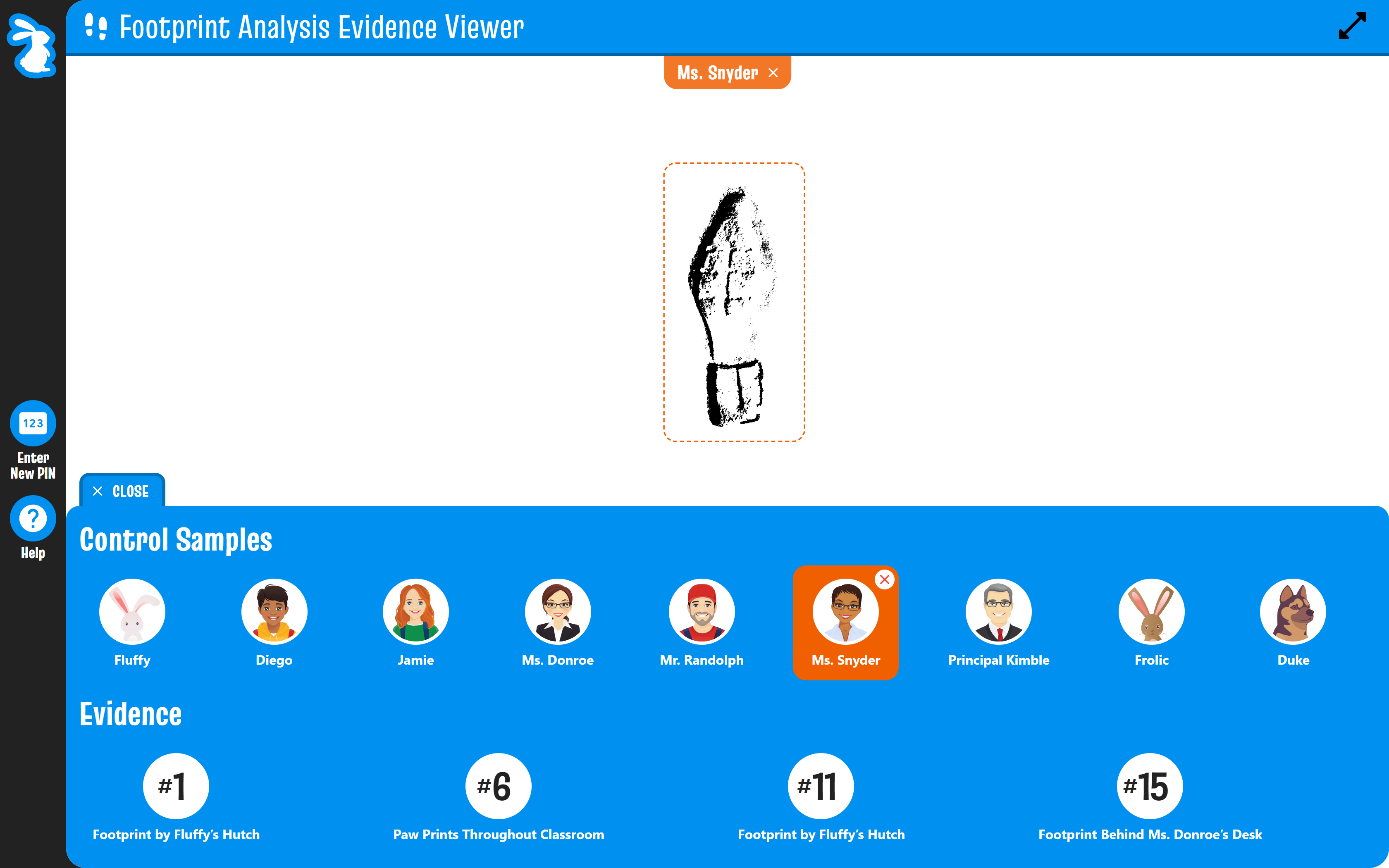Who Took Fluffy?® Real World Forensic Science Lab Activity: Footprint Analysis (Option A, 15/30 Students)
$229.00
Based on the Who Took Fluffy?® story, in this Footprint Analysis Lab students learn how to identify and examine footprints, including those of rabbits and dogs. Matching the control samples with the evidence, students determine which of the people involved in the case the footprint evidence belongs.
When conducted with the other labs in the activity, the student’s determinations reached in the Footprint Analysis Lab will help them to solve the case and get the answer to the question: Who Took Fluffy?®
Includes everything to support a class of 15/30 students. For grades 3 and up.
To learn more, click on the tabs below.
Based on the Who Took Fluffy?® story, in this Footprint Analysis Lab students learn how to identify and examine footprints, including those of rabbits and dogs. Matching the control samples with the evidence, students determine which of the people involved in the case the footprint evidence belongs.
When conducted with the other labs in the activity, the student’s determinations reached in the Footprint Analysis Lab will help them to solve the case and get the answer to the question: Who Took Fluffy?®
For grades 3 and up.
The Who Took Fluffy?® Footprint Analysis Lab includes everything to support a class of 15/30 students:
- Teacher’s Guide
- One copy master Student’s Guide
- One copy master “The Story of Who Took Fluffy®” booklet
- Black Ink Pad
- Hard Rubber Brayer/Roller
- Nitrile Gloves
- Shoes (Teacher provided)
- Clearly written, graphically-rich, easy-to-understand science lesson on Shoe Impression
- Easy-to-follow procedures for the lab activities
- Answer tables for the students to record their results and submit
- Everything included in the Student Guide
- Tips for the teacher on how to prepare for and conduct the lab
- The answer key
- Footprint Analysis Lab 1 - Analyze Control Samples And Match With Crime Scene Evidence – estimated time to complete – one 45-minute class/lab period
- Footprint Analysis Lab 2 - Using Inked Impressions For Control Samples – estimated time to complete – one 45-minute class/lab period
Materials included in this lab activity include enough of the tools and supplies below to support a class of 15/30 students.
- Shoeprint samples – Control
- Shoeprint samples– Evidence
Since their release in 2013, the Next Generation Science Standards (NGSS) have helped states and school districts in the U.S. to increase student engagement with natural scientific phenomenon at the nexus of three dimensions of learning; Science and Engineering Practices, Disciplinary Core Ideas, and Crosscutting Concepts.
The challenge for educators is how to present fun and engaging science lab activities that help their students achieve the objectives outlined in the NGSS. Who Took Fluffy?® Real World Forensic Science Lab Activity: Footprint Analysis (Option A, 15/30 Students) is such a lab activity.
Choose any of the options below to see how this lab activity aligns with the NGSS. To learn how Who Took Fluffy?® meets the standards in your state please contact us.
- Who Took Fluffy?® Real World Forensic Science Lab Activity: Footprint Analysis (Option A, 15/30 Students) strongly supports the first dimension in learning specified in the NGSS - Science and Engineering Practices.
The eight Science and Engineering Practices identified in the NGSS framework as essential for all students to learn are listed below followed by the specific way in which Who Took Fluffy?® Real World Forensic Science Lab Activity: Footprint Analysis (Option A, 15/30 Students) supports and promotes this practice:
- Asking questions (for science) and defining problems (for engineering) – The essential question for students conducting the Who Took Fluffy?® Real World Forensic Science Lab Activity: Footprint Analysis (Option A, 15/30 Students) Lab activity is What happened to Fluffy? In order to answer that question, the students must ask themselves: How can I determine what happened to Fluffy? and then through a series of lessons and lab activities they learn the science, apply the science, gather and interpret data and come to a reasoned determination based on evidence. In Who Took Fluffy?® Real World Forensic Science Lab Activity: Footprint Analysis (Option A, 15/30 Students), the questions arise from the need to solve a problem.
- Developing and using models – One of the key models used by students in Who Took Fluffy?® Real World Forensic Science Lab Activity: Footprint Analysis (Option A, 15/30 Students) is the classroom scene map. All the evidence is mapped here which forms the basis for the student's investigation and their resulting determinations. According to the NGSS, a diagram is considered a model. This model can show relationships among variables. In a simple example, what is the relationship between a sample a shoe impression that matches the shoes of one of the victims and the location in which it was found?
- Planning and carrying out investigations – There is a fully immersive lab activity in the Who Took Fluffy?® Real World Forensic Science Lab Activity: Footprint Analysis (Option A, 15/30 Students) lab. Teachers can choose to have students work individually or in groups to encourage collaborative problem-solving.
- Analyzing and interpreting data – In all of the Who Took Fluffy?® labs, and in the Shoe Impression Lab in particular, students gather data in the course of their investigation, analyze and interpret them. This interpretation becomes the raw material in constructing the narrative of the mystery and, ultimately, the arrival at a determination as to what happened to Fluffy and how.
- Using mathematics and computational thinking – In Who Took Fluffy?® , students must work their way within the three-dimensional space of the classroom scene and constitute an accurate understanding of the evidence and activity found therein.
- Constructing explanations (for science) and designing solutions (for engineering) – At the conclusion of the Who Took Fluffy?® Real World Forensic Science Lab Activity: Footprint Analysis (Option A, 15/30 Students) lab, students have compiled a report which summarizes the results of their investigation including the evidence to support their determinations.
- Engaging in argument from evidence – Students must make their determination as to what happened to Fluffy and then support their conclusion – make their argument – based on the evidence they discovered and analyzed. It is quite possible for students in the same class to credibly argue a case that points to a different explanation.
- Obtaining, evaluating, and communicating information – In the Shoe Impression Lab, and throughout the six Lessons and five Lab Activities in Who Took Fluffy?® , students evaluate the evidence from the mystery scene, analyze this evidence in the lab and communicate and record this data. Later this data is compared with data from the control samples and a determination is made as to whom the DNA evidence may have originated.
- In the Who Took Fluffy?® lab activities, the following labs support NGSS Disciplinary Core Ideas:
- The Story
- Blood Typing - PS1.2: Chemical Reactions
- Hair Analysis
- Fingerprint Analysis
- Shoe Impressions - PS2-3: Motion and Stability: Forces and Interactions
- Fiber Analysis
- The NGSS defines crosscutting concepts as those that “unify the study of science and engineering through their common application across fields.” The NGSS Framework recommends that science lessons, labs and activities are embedded with these crosscutting concepts through all grades because they:
- Help students better understand core ideas in science and engineering
- Help students better understand science and engineering practices
- Help to build familiarity with these concepts through repetition in different contexts
- Extend their growth in complexity and sophistication across the grades
- Can provide a common vocabulary for science and engineering
- Are for all students
- Cause and Effect: Mechanism and Explanation
- Systems and System Models
1. Crosscutting Concepts - Cause and Effect: Mechanism and Explanation
Cause and effect: Mechanism and Explanation. “Events have causes, sometimes simple, sometimes multifaceted. A major activity of science is investigating and explaining causal relationships and the mechanisms by which they are mediated. Such mechanisms can then be tested across given contexts and used to predict and explain events in new contexts.” In the Who Took Fluffy?® Real World Forensic Science Lab Activity: Footprint Analysis (Option A, 15/30 Students) lab, the effect is the disappearance of Fluffy. How did this happen? is the guiding question in the investigation to determine the cause of this effect. To do so, students must engage in a series of scientifically-based lab activities which include:- The Story
- Blood Typing
- Hair Analysis
- Fingerprint Analysis
- Shoe Impression
- Fiber Analysis
“When students engage in scientific argumentation, it is often centered about identifying the causes of an effect.”
The Who Took Fluffy?® Real World Forensic Science Lab Activity: Footprint Analysis (Option A, 15/30 Students) lab addresses this as well. In the culminating report, students present their case and supporting data. This compels them to argue from evidence. Further supporting the NGSS, solving this case helps students to understand that empirical evidence is required to differentiate between causation and correlation. It is made clear to the student, for example, that evidence found in the classroom, may be a correlative connection to an individual but is not a causative connection between that individual and the answer to the mystery of what happened to Fluffy. Additional corroborative evidence is necessary to prove causation.2. Crosscutting Concepts - Systems and System Models
The NGSS defines Systems and System Models as: “Defining the system under study—specifying its boundaries and making explicit a model of that system—provides tools for understanding and testing ideas that are applicable throughout science and engineering.” Who Took Fluffy?® Real World Forensic Science Lab Activity: Footprint Analysis (Option A, 15/30 Students) reinforces the crosscutting concept of Systems and System Models. In the Who Took Fluffy?® Real World Forensic Science Lab Activity: Footprint Analysis (Option A, 15/30 Students) lab, the classroom scene map becomes an essential model throughout the activity and particularly when students must “Construct and present arguments using evidence to support the claim.” This map supports the following notion articulated in the NGSS:“In the laboratory or even in field research, the extent to which a system under study can be physically isolated or external conditions controlled is an important element of the design of an investigation and interpretation of results.”
- Who Took Fluffy?® helps to reinforce the nature of scientific enterprise which the NGSS recognizes as being essential for every educated citizen.
The eight basic understandings about the Nature of Science as outlined by the NGSS are presented below in a matrix that demonstrates the way in which Who Took Fluffy?® supports each of these understandings:
- Scientific Investigations Use a Variety of Methods
- Who Took Fluffy?® students use a variety of methods in the lab activities. In the case of the Who Took Fluffy?® Real World Forensic Science Lab Activity: Footprint Analysis (Option A, 15/30 Students) lab, these include observation, critical analysis, data recording and comparative analysis.
- Scientific Knowledge is Based on Empirical Evidence
- In the Who Took Fluffy?® Real World Forensic Science Lab Activity: Footprint Analysis (Option A, 15/30 Students) lab, students conduct close analyses and interpretation of data for the shoe impression evidence and the control samples and accurately record their findings. The students’ determinations as to whom a piece of evidence might be associated with and ultimately who may have committed the mystery are based on and supported by evidence – not speculation. In short, students make and defend a claim based on evidence and thereby come to understand the difference between cause and correlation.
- Scientific Knowledge is Open to Revision in Light of New Evidence
- If the initial analysis of some of the evidence is tending toward a determination, students are compelled to withhold final determination until all the evidence and control samples have been analyzed.
- Scientific Models, Laws, Mechanisms, and Theories Explain Natural Phenomena
- Students use the classroom map as the framework for the entire lab activity. As the evidence, analysis and determinations construct the narrative of the mystery, it must be based cogently within the framework of this primary model.
- Science is a Way of Knowing
- The determinations arrived at through the conduct of forensic science forms a narrative, an explanation, of the phenomenon that had occurred – the disappearance of Fluffy. Using the modern tools and techniques of today’s forensic scientists, students compare their findings with other class members.
- Scientific Knowledge Assumes an Order and Consistency in Natural Systems
- The forensic science labs conducted by students during this investigation reinforces this notion of an order and consistency in natural systems. Students learn for example that the weight of the individual wearing the shoe will have an orderly and consistent effect on the amount of displacement made by the shoe impression.
- Scientific knowledge is based on the assumption that natural laws operate today as they did in the past and they will continue to do so in the future. (HS-LS4-1),(HSLS4-4)
- In Who Took Fluffy?® students use the modern knowledge, skills and tools of forensic science and apply them to this case. During the conduct of the labs, this assumption is affirmatively reinforced repeatedly: that the natural laws that operate today did in the past and will so in the future.
- Science is a Human Endeavor
- What is particularly beneficial about Who Took Fluffy?® is that the notion that science is a human endeavor put to the task of human betterment is strongly reinforced. In this case, students must find out what happened to a beloved member of the animal kingdom - Fluffy, the little white rabbit - and the are encouraged to do so with persistence and compassion. Teachers are encouraged to have students and/or student/groups share their approaches and their findings with the other members of their class. Students can do so with written, oral and video presentations.
- Science Addresses Questions About the Natural and Material World
- The two primary questions posed by the Who Took Fluffy?® lab activity are: How did this happen? and Who did it? In answering these questions, students properly learn and apply science.
“The point is to provide an instructional context that bridges tactics and strategies with practices and the nature of science, through understanding the role of systems, models, patterns, cause and effect, the analysis and interpretations of data, the importance of evidence with scientific arguments, and the construction of scientific explanations of the natural world.”
- Who Took Fluffy?® begins with what the NGSS calls a phenomenon and proceeds into a deepened engagement and context made possible by “Phenomenon-Based Learning.” As stated in the NGSS: “By centering science education on phenomena that students are motivated to explain, the focus of learning shifts from learning about a topic to figuring out why or how something happens.” In Who Took Fluffy?® , the initiating phenomenon is the mysterious disappearance of Fluffy, the mascot in Ms. Donroe's class. This is a suitable phenomenon in the NGSS framework because the anchoring phenomenon is understandable prior to the investigation. When the students left school the day before, Fluffy was there in the class; when they returned the next day, the rabbit was missing. What happened to cause this? The students do so in an ordered, step-by-step process to determine how this phenomenon occurred. Anchored as it is in this real event, Who Took Fluffy?® helps move students away from what the NGSS calls “decontextualized knowledge that students are unable to apply” in other applications. Rather Who Took Fluffy?® helps students “build more usable and generative knowledge” - problem-solving techniques that can be applied to other in-depth investigations. The investigation and explanation what happened to Fluffy is certainly a compelling phenomena that, as it says in the NGSS guidelines, “students find interesting, relevant and consequential” to support their engagement. This becomes the anchoring phenomenon which is followed and closely supported by investigative phenomenon throughout the Who Took Fluffy?® lab activities. In these ways and others, Who Took Fluffy?® strongly encourages the learning and application of science because it is grounded in phenomenon.
- Who Took Fluffy?® also strongly supports the notion of “Storylines” as set forth in the NGSS standards.
“A storyline is a coherent sequence of lessons, in which each step is driven by students' questions that arise from their interactions with phenomena.”
Who Took Fluffy?® is a narrative that involves characters with histories, and it presents these in a narrative-based format to the student. mystery scenes themselves are a type of narrative. To understand the mystery, students use a sense of place, the classroom scene, and then construct the narrative of the mystery based on the evidence found at the scene. One could say that it is storytelling using space rather than time as its primary dimension of storytelling. Most narratives are told in time sequence - with a beginning, a middle and an end. In the case of Who Took Fluffy?® , time is fixed at a single point – the morning after Fluffy's disappearance – and space is the primary means of telling the narrative. How is the narrative told? By using the scientific basis of phenomenon in order to reconstruct the events that took place and the people who may have been responsible for those events. So, Who Took Fluffy?® is not just a series of lessons, it’s an opportunity for the student’s own curiosity and ingenuity to 'build a case' as to what happened to Fluffy, very much like an actual forensics investigator. In Who Took Fluffy?® , students are prompted to build their case based on their own investigation or that of their group in a coherent series of labs. Their determination will be based on sound science supported by accurate data as they work their way through the lessons and labs. It is the coherence of the student’s storyline that supports the NGSS standards, an evidence-based lab activity that arises from a student’s interaction with the phenomenon, not the instructor’s. - The NGSS recognizes the connection between mathematics and science.
“Science is a quantitative discipline, so it is important for educators to ensure that students’ science learning coheres well with their learning in mathematics.”
The three CCSSM (Common Core State Standards for Math) practice standards most directly relevant to science are:- Reason abstractly and quantitatively - The entire Who Took Fluffy?® activity is an exercise in abstract reasoning, in the sense that the students are challenged to investigate what happened from the time the students in Ms. Donroe's class left school at the end of one day to the time they arrived back to school the following morning. Quantitative reason is applied particularly through the gathering of the evidence from the classroom scene, its analysis in the lab activities, and the interpretation of the data generated through these functions.
- Model with mathematics - In Who Took Fluffy?® , students must work their way within the three-dimensional space of the classroom scene and constitute an accurate understanding of the evidence and activity found therein.
- Use appropriate tools strategically - Conducting the labs, students use a variety of tools and, in the case of the online activity, a variety of digital tools as well, including digital microscopes and digital data recording devices. These tools are used strategically throughout the conduct of the various lab activities as they lead through the comprehensive investigation of the mystery.
- The NGSS recognizes the connection between literacy and building knowledge in science “including understanding the nature of evidence used, an attention to precision and detail, and the capacity to make and assess intricate arguments, synthesize complex information, and follow detailed procedures and accounts of events and concepts.” In addressing this, the NGSS development team worked closely with the literacy team of the Common Core State standards “to identify key literacy connections to the specific content demands outlined in the NGSS.” In supporting the NGSS, Who Took Fluffy?® therefore also supports these CCSS standards in literacy. Who Took Fluffy?® Real World Forensic Science Lab Activity: Footprint Analysis (Option A, 15/30 Students) lab provides written and illustrated documents as an important basis for the understanding of the mystery narrative upon which the science is based. Furthermore, as a culminating project at the end of the activity, students submit a short report summarizing their determinations. This report must include their determinations supported coherently by evidence and the data from their lab reports in an articulate demonstration of their mastery of these science concepts.




